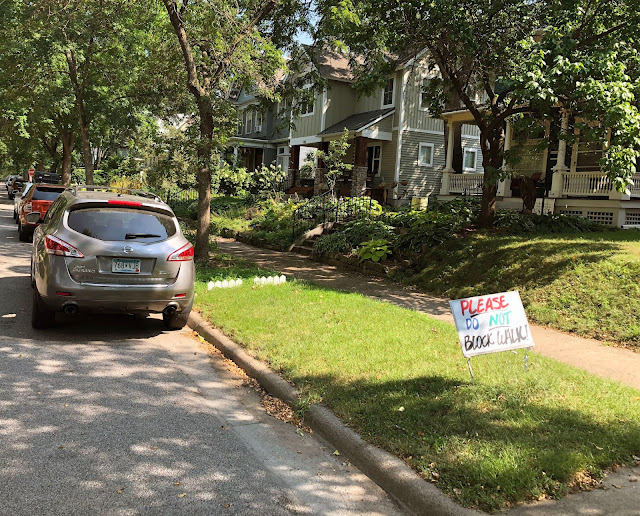 |
[Yesterday's Strib headline.]
|
The goal of good journalism is to, first, say what happened and, second, provide context for understanding it. I've been frustrated lately with how accounts of the referendum debate have described the situation in Minneapolis. I'm going to use two Star Tribune articles about the Charter Commission debate to explain why.
First off, I am a Star Tribune subscriber and will continue to be one. Despite
my disagreements with their Editorial Page, I think everyone who values journalism in the Twin Cities should subscribe. It's one of the best newspapers in the country and, especially at a moment when journalism is in crisis, we're lucky to have it in Minneapolis.
That said, I've been disappointed with the paper's coverage of the aftermath of the George Floyd murder, protests, and debate about police reform. The latest examples have been the coverage of the Charter Commission debate. I'll use two stories --
one from July 28th and one from yesterday,
August 5th -- to illustrate.
Here are three things newspaper accounts are missing about the debate:
1. Reporters are ignoring the 12-0 unanimous vote
This is an big omission. Neither of the Star Tribune articles mentions
the unanimous resolution by the Minneapolis City Council to put the ordinance on the ballot. Instead, both articles mention the “five council members” when describing the ballot question.
In a "weak mayor" city like Minneapolis, a unanimous vote by the City Council is a big deal, and that kind of support is a key piece of context. While every Council Member might not have supported the ballot question, they all supported getting it on the ballot. Readers of these articles would not even know that the ballot question passed unanimously.
2. The term “controversial"
Both Star Tribune articles describe the ballot question as "controversial", even putting the term in yesterday's headline.
That loaded term begs the questions: Controversial in what way? Who or what is controversial here? Controversial for whom?
There's certainly a lot of controversy to go around in Minneapolis these days! In my opinion, the most controversial thing in Minneapolis this summer has been the Minneapolis Police Department as a whole, and their police union and head Bob Kroll, in particular. The existing department is so controversial, it incited some of the largest demonstrations and worst public violence in city history. In fact, the Minneapolis Police Department is so controversial, people protested their actions in dozens of countries around the world for weeks.
It's certainly debatable whether a ballot measure that received the unanimous support of the City Council is controversial. My reading of the situation is that the only reason the ordinance is "controversial" is that the Mayor and his appointed Police Chief are opposing it. A better framing of this issue would be to describe the rift between the Council and the Mayor's Office, which are on opposite sites of this debate. That's the controversy, and its a political one.
Beyond that, whether or not the ordinance is controversial seems a matter of opinion. Needless to say, there's a very high bar for what is deemed controversial these days.
3. The pieces do not accurately sum up the public comment
Both articles take a "both sides" approach to the public comment received by the Charter Commission, which is fine to a degree. But accounts should also make clear the overwhelming support for the ballot question they received during their public hearings.
John, at Wedge Live, has
been keeping close track of the public engagement and testimony, and if we are to give any weight to the public engagement that occurred over the last few weeks, accounts should make note of the strong support for putting the Council's proposal on the ballot.
[IMO, the AP does a better job of framing the story, but still leaves out key context.]
I certainly have other gripes with the reporting, in both the Star Tribune and elsewhere. I'd like more information about the Charter Commission, particularly about its theoretical and
de facto roles in Minneapolis politics. I'd like to see more context about ongoing structural problems between the Minneapolis Police Department, their union, and City Hall. I'd also like to see all these debates placed within the larger framework of George Floyd's murder and ongoing police killings
[e.g. the AP tweet at right]. I think this context is critical to understanding the story.
To be sure, this issue is complex, wide-ranging, and abundant with in-the-weeds details. Covering this the political debate around the Minneapolis Police Department is a challenging task.
But at the very least, it's obligation of our journalists to put this debate in the context of structural issues around controlling and changing the Minneapolis Police Department. I wish we could turn to journalists and more easily learn the full story of what's going on, and the fact that the best coverage of this story has been from
the Wedge Times-Picayune is both frustrating and delightful.
It sure would be nice to have an election that allowed people to decide for themselves the future direction of the Minneapolis Police Department. The real controversy here is that a unanimous vote by the city's highest elected body was filibustered by a group of unaccountable volunteer commissioners.

























